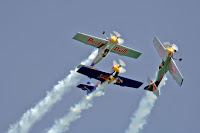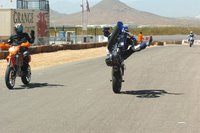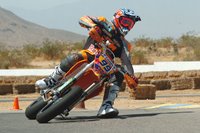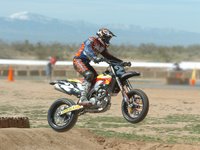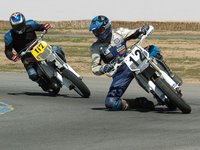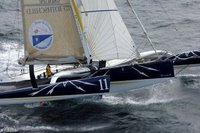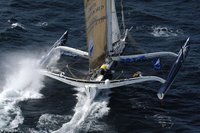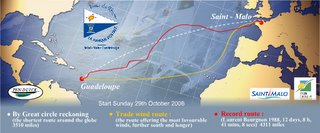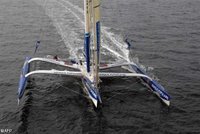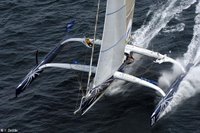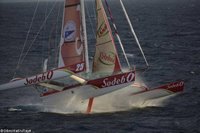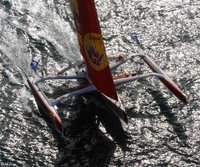Earthrace
60 days 23 hours 49 mins
In June 2008, the amazing Earthrace vessel set a new world record for a powerboat to circle the globe, and she did this with 100% renewable biodiesel fuel, and a net zero carbon footprint. The voyage was over 24,000 nautical miles, and took 60 days, 23 hours and 49 minutes, smashing the old reocrd by over two weeks.

Boat:
Earthrace is a 24m (78ft) tri-hull wavepiercer that has been designed and built specifically to get the record for a powerboat to circumnavigate the globe. She is an advanced endurance vessel, capable of submarining up to 7m (23ft) underwater as she powers across oceans. One journalist recently reported "Earthrace is like a rally car but for oceans, with her ability to handle rough seas and storm conditions at high speed."
The horns
There are a many features that stand out on Earthrace. Firstly the distinctive horns. These are actually ducts. Hot air from around the engines is expelled out the top of these, while cool air is sucked through the lower channel and funnelled under the engines. This however is not powered, it runs simply by convection. In big seas (waves over 8m (26ft)) the horns get submerged, however any water ingress is ducted out the sides automatically. Also, because Earthrace is only underwater for a few seconds at a time, the engine bay holds enough air to keep the 1080hp of Cummins Mercruiser engine roaring along.Another feature about Earthrace is her unusual appearance, especially the extremely narrow hulls and flowing lines. She has this shape to allow her to pass easily through waves, rather than riding over the top like conventional designs.
Hulls
Another feature about Earthrace is her unusual appearance, especially the extremely narrow hulls and flowing lines. She has this shape to allow her to pass easily through waves, rather than riding over the top like conventional designs.
Range
The range of Earthrace depends on speed. At 6 knots she can go an incredible 13,000nm (24,000km) on one tank of biodiesel. That's over half way around the globe! Of course your crew gets grumpy at 6kn when you're in such a high speed vessel. At 25 knots she has a range of about 2,000nm (3,700km).

Helm
Much of the Earthrace helm has been modelled on race cars. Recent additions to the helm are custom carbon / kevlar racing seats by Corbeau and a custom made pre-preg carbon steering wheel by Reverie.
Specifications:
- Hull: Wavepiercing Trimaran
- Designer: Craig Loomes Design Group
- Builder: Calibre Boats
- Length: 24m (78ft)
- Beam: 8m (24ft)
- Draft: 1.3m (4ft)
- Range at 6 knots: 13,000nm (24000km)
- Range at 25 knots 2,000 nm (2,700km)
- Maximum speed: 40 knots (75km/h)*
- Fuel: B100 Biodiesel (100%)
- Fuel Capacity: 12,000 liters (3,000 gallons)
- Dry Weight: 14 ton
- Weight fully fuelled: 26 ton
- Construction: Carbon , Kevlar sandwich composites
- Crew: 4
- Beds: 6
- Engines: 2 x QSC - 540 ( Cummins Mercruiser Diesel 540 hp)
- Gearboxes: ZF 305A (ZF)
- Air intakes: top of wings to remain above waves while piercing
- Windscreen: 17mm laminated toughened glass
- max speed is dependent on fuel load, propellor pitch, and gearbox ratio.






